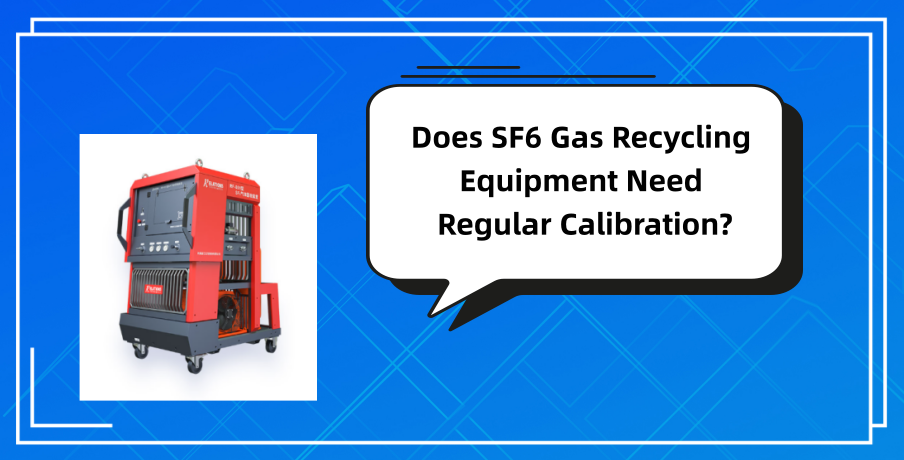
Does SF6 Gas Recycling Equipment Need Regular Calibration?
Yes, SF6 gas recycling equipment requires regular calibration to ensure accurate performance, compliance with environmental regulations, and safe operation. Here’s a detailed breakdown based on technical standards, manufacturer guidelines, and practical requirements:
1. Regulatory and Standards Requirements
- DL/T 2756—2024 (China): This standard mandates that instruments used for gas analysis (e.g., moisture meters, purity analyzers) must be calibrated with an error tolerance of ≤±5% . While the term “instruments” includes sensors and analyzers integrated into recycling equipment, the scope implicitly applies to core components like pressure sensors and flow meters critical for gas recovery efficiency.
- IEC 60480:2019: This international standard specifies purity and impurity limits for recycled SF6 (e.g., ≥99.8% purity) . Achieving these standards requires reliable measurement systems, which depend on periodic calibration to avoid drift.
- EU F-Gas Regulation (2024): While not explicitly mentioning calibration, it mandates leak checks for equipment containing SF6 and strict reporting of emissions . Calibration of pressure sensors and leak detection systems is essential to meet these requirements.
2. Manufacturer Recommendations
DILO (Leading Manufacturer): Their equipment manuals emphasize the need for sensor and module calibration (e.g., moisture, purity, and decomposition product sensors) . For example, the B2000R04 model’s pressure sensors and control valves require periodic checks to ensure accurate pressure regulation during gas recovery and purification.
Riken Keiki: Their gas monitors and analyzers are recommended for semi-annual calibration to maintain accuracy, with sensor replacements at specified intervals . This applies to integrated components in recycling systems.
3. Technical Necessity
Critical Components: Recycling equipment relies on pressure sensors, flow meters, and vacuum gauges to control processes like compression, purification, and storage. Drift in these components can lead to incomplete gas recovery, contamination, or equipment damage. For instance:
A malfunctioning pressure sensor might fail to stop the compressor at the correct pressure, causing over-pressurization .
Inaccurate flow meters could result in insufficient gas purification, violating purity standards .
Environmental and Safety Risks: Poor calibration increases the risk of SF6 leaks, which have a global warming potential (GWP) 23,900 times that of CO₂ . Regular calibration ensures leak detection systems (e.g., mass spectrometers) function optimally.
4. Calibration Practices and Intervals
Frequency:
- Analyzers and Sensors: Typically calibrated every 1–2 years or after significant repairs .
- Pressure and Vacuum Systems: Annual checks are common, with more frequent calibration in high-humidity or corrosive environments .
- Manufacturer-Specific Intervals: Some models require calibration after 1,000–2,000 hours of operation or based on error alerts .
Methods:
- Traceable Standards: Calibration must reference national or international standards (e.g., NIST, ISO 17025) to ensure measurement accuracy .
- Functional Testing: Includes checks for pressure regulation, leak tightness, and recovery efficiency .
5. Consequences of Neglecting Calibration
- Non-Compliance: Failing to meet purity standards (e.g., ≤150 μL/L moisture content) can result in regulatory penalties or rejection of recycled gas.
- Operational Inefficiencies: Drifted sensors may cause longer recovery times, higher energy consumption, or premature component failure .
- Safety Hazards: Inaccurate pressure control can lead to explosions or releases of toxic decomposition products (e.g., SO₂, HF) .
6. Documentation and Certification
Record-Keeping: Calibration logs must be maintained for audit purposes, documenting dates, methods, and results .
Third-Party Certification: Some utilities and industries require ISO 17025-accredited calibration to ensure compliance with quality management systems .
SF6 gas recycling equipment must undergo regular calibration to ensure regulatory compliance, operational efficiency, and environmental safety. While specific intervals vary by component and manufacturer, a proactive approach—including annual checks, sensor recalibration, and adherence to traceable standards—is essential. Neglecting calibration risks financial losses, environmental harm, and safety incidents, underscoring its critical role in SF6 lifecycle management.

